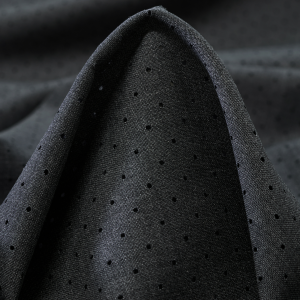In the ever-evolving world of fashion and textiles, innovation knows no bounds. Among the myriad techniques used to transform fabrics, CO2 laser fabric perforation stands out as a precise, versatile, and efficient method. This cutting-edge technology has revolutionized the textile industry, offering designers and manufacturers a new realm of creative possibilities. In this article, we explore the fascinating world of CO2 laser fabric perforation, shedding light on its applications, benefits, and artistic potential.
One of the most notable applications of CO2 laser fabric perforation is in sportswear. Athletes benefit from enhanced breathability, moisture-wicking properties, and improved temperature regulation. Laser-perforated sportswear garments keep athletes comfortable and focused during rigorous activities.
The fashion industry has embraced CO2 laser fabric perforation for its ability to create unique and visually stunning designs. Designers use laser perforation to craft intricate patterns, cutouts, and embellishments that add a touch of elegance and individuality to clothing.
Laser-perforated curtains, drapes, and upholstery fabrics can elevate interior decor by introducing patterns that play with light and shadow. This technology allows homeowners to personalize their living spaces with innovative designs.
Car manufacturers use CO2 laser fabric perforation to create visually appealing patterns in automotive upholstery. Perforated seats and interior fabrics provide a balance between style and comfort.
In industrial and technical textiles, laser perforation finds applications in filtration systems, acoustic materials, and medical textiles. Precise perforations help improve functionality and performance in these specialized domains.
CO2 laser fabric perforation has redefined the boundaries of textile design and manufacturing. Its precision, speed, and versatility make it a go-to choice for industries ranging from sportswear and fashion to automotive and technical textiles.
As designers continue to explore their creative potential, this cutting-edge technology will undoubtedly play an increasingly vital role in shaping the future of fabrics and textiles. The fusion of art and science in CO2 laser fabric perforation exemplifies how innovation can transform the every day into the extraordinary.
Clothing perforating, often regarded as an intricate art form in the world of fashion, has evolved significantly over the years. While the concept might sound simple – creating holes or perforations in fabric – the techniques and applications are incredibly diverse.
From enhancing aesthetics to improving functionality, clothing perforating has become a powerful tool in the hands of designers and manufacturers. In this article, we delve into the fascinating world of clothing perforating, exploring its history, techniques, and contemporary applications.
The practice of perforating clothing can be traced back centuries, with origins rooted in both necessity and decoration.

In the past, artisans employed hand tools to create intricate patterns of holes in fabrics, often for practical purposes like ventilation or to reduce the weight of heavy garments. However, clothing perforating also served as a means of artistic expression. Many ancient civilizations, including the Egyptians and Greeks, used this technique to adorn their garments with elaborate patterns and motifs. In the pre-industrial era, clothing perforation was a labor-intensive process, relying on skilled craftsmanship.
article source: https://www.mimowork.com/news/laser-fabric-perforation-article/
Media Contact
Company Name: Mimowork
Email: Send Email
Country: China
Website: https://www.mimowork.com/
